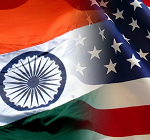In a remarkable break from tradition, Prime Minister Narendra Modi has invited President Barack Obama to be the chief guest at the Republic Day parade in New Delhi. Many commentators have focused on the extraordinary symbolism of this gesture, given Modi’s past fraught relationship with the United States. What is unknown as yet is if Obama’s second visit to the country is likely to yield any tangible results. Thus far, both sides have chosen not to specify any potential agreements, though speculation about what might be accomplished is rife.
Certainly, Secretary of State John Kerry dramatically raised long-term expectations when, at the Vibrant Gujarat Summit (January 11-13), he spelled out a vision for expanding India-U.S. trade to $500 billion in the foreseeable future. Despite this expansive goal, important differences still dog the bilateral commercial relationship. Quite apart from the usual litany of complaints by American companies about India’s sagging infrastructure, antiquated labour laws, and slothful bureaucratic procedures, progress in a number of areas has been hobbled because of existing Indian policies.
For example, the most obvious stumbling block to U.S. investment in India’s civilian energy market remains the draconian law on compensation. Some reports suggest that quiet efforts are underway for a possible pathway that skirts the law and thereby assuages American concerns. However, until such an agreement is actually unveiled, any possible understanding is little more than mere speculation. Similarly, the U.S. remains at odds with India on the matter of solar energy because of a requirement that necessitates utilising domestic products in any solar enterprise.
These difficulties also extend to the defence arena. Even though India has purchased over $10 billion worth of U.S. military equipment over the past decade, it remains hesitant to expand the scope of the India-U.S. defence relationship. Among other matters, late last year it chose to forego the possible co-production of the Javelin anti-tank missile and instead decided to turn to Israel for its Spike missile. And long after shunning the U.S.’s offers for the Medium Multi-Range Combat Aircraft the country still remains mired in the seemingly interminable negotiations to acquire France’s Rafale.
Even at a strategic and political level, the two sides remain somewhat distrustful. From India’s standpoint, the U.S. has failed to forthrightly confront Pakistan for its continuing dalliance with terror in Kashmir and in Afghanistan. Indeed, Kerry’s somewhat off-the-cuff remark in Islamabad late last year about the Pakistan Army as a “binding force” for the country raised the hackles of a number of Indian commentators on foreign and security policy.
There is no gainsaying that all these policy differences are genuine and cannot be elided over. However, there are deeper, more profound, developments both within the region and globally, that should provide the basis for a closer relationship.
First, despite professing a peaceful rise, the increasing assertiveness of China in the Pacific and even in the Indian Ocean should lead to greater India-U.S. strategic cooperation. Even before Modi had assumed office, India was quietly improving its ties with Japan, South Korea, and Vietnam. These have been given a boost under the Modi regime. There is little or no reason that India should not also expand the band of its strategic discussions with the U. S. to confront an increasingly uncertain security milieu in its extended neighborhood.
Related to the questions surrounding China’s intentions is also the vital issue of cybersecurity. A range of cyber attacks on the U.S. have stemmed from China. Also, much of India’s cyber security infrastructure is inadequate and has been penetrated on a number of occasions. Given an obvious shared concern for securing cyber infrastructure, expanding the scope of cooperation with the U.S. seems to be a natural imperative.
Even seemingly contentious regional security issues, with a bit of imagination, can be tackled during this visit. For example, rather belatedly, the U.S. has recognised the benefit of an Indian footprint in Afghanistan. Given that the U.S. military drawdown is now well underway and the future stability of the country is in question, a candid discussion of a possible expansion of the Indian role during the Obama visit seems to be especially appropriate.
It is perhaps too much to expect that a single presidential visit can transform a relationship that has had its share of vicissitudes during the Cold War and thereafter. However, it is a time when the U.S. is confronting a number of challenges across Asia. Given that the India-U.S. relationship, after much past recriminations, is now on a somewhat secure footing, the second Obama visit may well hold the prospect of at least deepening and broadening existing ties to considerable mutual benefit.
Sumit Ganguly is a professor of political science, holds the Rabindranath Tagore Chair in Indian Cultures and Civilizations, and directs the Center on American and Global Security at Indiana University, Bloomington, U.S. He is also a Senior Fellow at the Foreign Policy Research Institute in Philadelphia.
This article was exclusively written for Gateway House: Indian Council on Global Relations. You can read more exclusive content here.
For interview requests with the author, or for permission to republish, please contact outreach@gatewayhouse.in.
© Copyright 2015 Gateway House: Indian Council on Global Relations. All rights reserved. Any unauthorized copying or reproduction is strictly prohibited


